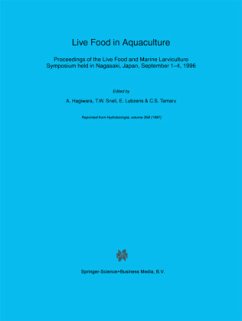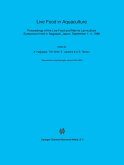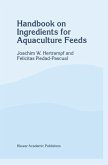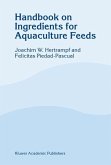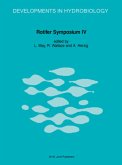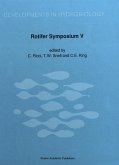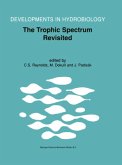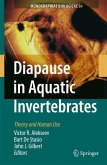HagiwaraProceedings of the Live Food and Marine Larviculture Symposium held in Nagasaki, Japan, September 1¿4, 1996
Live Food in Aquaculture
Proceedings of the Live Food and Marine Larviculture Symposium held in Nagasaki, Japan, September 1¿4, 1996
Herausgegeben:Hagiwara, A.; Snell, T. W.; Lubzens, E.; Tamaru, C. S.
HagiwaraProceedings of the Live Food and Marine Larviculture Symposium held in Nagasaki, Japan, September 1¿4, 1996
Live Food in Aquaculture
Proceedings of the Live Food and Marine Larviculture Symposium held in Nagasaki, Japan, September 1¿4, 1996
Herausgegeben:Hagiwara, A.; Snell, T. W.; Lubzens, E.; Tamaru, C. S.
- Gebundenes Buch
- Merkliste
- Auf die Merkliste
- Bewerten Bewerten
- Teilen
- Produkt teilen
- Produkterinnerung
- Produkterinnerung
This proceedings volume includes selected papers presented at the international symposium `Live Food Organisms in Marine Larviculture' held in Nagasaki, Japan, September 1-4 1996. This international symposium focused on live food organisms for the larval rearing of marine animals. Recent achievements in the fundamental biology (such as physiology, ecology, taxonomy, life cycle and nutrition) of live planktonic animals used as feed in aquaculture were combined with recent technological advances on larval rearing methods. This volume also provides future directions for the application of basic science to the rearing of aquatic animals.…mehr
Andere Kunden interessierten sich auch für
![Live Food in Aquaculture Live Food in Aquaculture]() Live Food in Aquaculture121,99 €
Live Food in Aquaculture121,99 €![Handbook on Ingredients for Aquaculture Feeds Handbook on Ingredients for Aquaculture Feeds]() J. W. HertrampfHandbook on Ingredients for Aquaculture Feeds168,99 €
J. W. HertrampfHandbook on Ingredients for Aquaculture Feeds168,99 €![Handbook on Ingredients for Aquaculture Feeds Handbook on Ingredients for Aquaculture Feeds]() J. W. HertrampfHandbook on Ingredients for Aquaculture Feeds166,99 €
J. W. HertrampfHandbook on Ingredients for Aquaculture Feeds166,99 €![Rotifer Symposium IV Rotifer Symposium IV]() MayRotifer Symposium IV168,99 €
MayRotifer Symposium IV168,99 €![Rotifer Symposium V Rotifer Symposium V]() C. Ricci / T.W. Snell / C.E. King (eds.)Rotifer Symposium V111,99 €
C. Ricci / T.W. Snell / C.E. King (eds.)Rotifer Symposium V111,99 €![The Trophic Spectrum Revisited The Trophic Spectrum Revisited]() ReynoldsThe Trophic Spectrum Revisited125,99 €
ReynoldsThe Trophic Spectrum Revisited125,99 €![Diapause in Aquatic Invertebrates Diapause in Aquatic Invertebrates]() Diapause in Aquatic Invertebrates121,99 €
Diapause in Aquatic Invertebrates121,99 €-
-
-
This proceedings volume includes selected papers presented at the international symposium `Live Food Organisms in Marine Larviculture' held in Nagasaki, Japan, September 1-4 1996. This international symposium focused on live food organisms for the larval rearing of marine animals. Recent achievements in the fundamental biology (such as physiology, ecology, taxonomy, life cycle and nutrition) of live planktonic animals used as feed in aquaculture were combined with recent technological advances on larval rearing methods. This volume also provides future directions for the application of basic science to the rearing of aquatic animals.
Hinweis: Dieser Artikel kann nur an eine deutsche Lieferadresse ausgeliefert werden.
Hinweis: Dieser Artikel kann nur an eine deutsche Lieferadresse ausgeliefert werden.
Produktdetails
- Produktdetails
- Developments in Hydrobiology 124
- Verlag: Springer / Springer Netherlands
- Artikelnr. des Verlages: 978-0-7923-4970-9
- Repr. d. Ausg. v. 1997
- Seitenzahl: 348
- Erscheinungstermin: 30. April 1998
- Englisch
- Abmessung: 266mm x 198mm x 24mm
- Gewicht: 1024g
- ISBN-13: 9780792349709
- ISBN-10: 0792349709
- Artikelnr.: 24499753
- Herstellerkennzeichnung
- Books on Demand GmbH
- In de Tarpen 42
- 22848 Norderstedt
- info@bod.de
- 040 53433511
- Developments in Hydrobiology 124
- Verlag: Springer / Springer Netherlands
- Artikelnr. des Verlages: 978-0-7923-4970-9
- Repr. d. Ausg. v. 1997
- Seitenzahl: 348
- Erscheinungstermin: 30. April 1998
- Englisch
- Abmessung: 266mm x 198mm x 24mm
- Gewicht: 1024g
- ISBN-13: 9780792349709
- ISBN-10: 0792349709
- Artikelnr.: 24499753
- Herstellerkennzeichnung
- Books on Demand GmbH
- In de Tarpen 42
- 22848 Norderstedt
- info@bod.de
- 040 53433511
The status of marine fish larval-rearing technology in Australia.- Development and achievements of marine fish-rearing technology in France over the last 15 years.- Mariculture in Israel - past achievements and future directions in raising rotifers as food for marine fish larvae.- Present status of larval-rearing technology in Korea.- Larval-rearing technology of marine species in Norway.- Collection and culture of live foods for aquaculture in Taiwan.- Status of marine larviculture in Thailand.- Marine finfish hatchery technology in the U.S.A. - status and future.- Effects of asexual reproduction on the neighborhood area of cyclical parthenogens.- Speciation in monogonont rotifers.- Comparative binding of antibody to a mate recognition pheromone on female Brachionus plicatilis and Brachionus rotundiformis (Rotifera).- Nitrogen-flow in the rotifer Brachionus rotundiformis and its significance in mass cultures.- Energy content of rotifers (Brachionus plicatilis and Brachionus rotundiformis) in relation to temperature.- Some properties of ?-1,3-glucan hydrolyzing enzymes from the rotifer Brachionus plicatilis.- Ultrastructure of the rotifer Brachionus plicatilis.- Genetic variation among marine Brachionus strains and function of mate recognition pheromone (MRP).- Effect of some vertebrate and invertebrate hormones on the population growth, mictic female production, and body size of the marine rotifer Brachionus plicatilis Müller.- Interspecific interactions in the marine rotifer microcosm.- Algae and rotifer turbidostats: studies on stability of live feed cultures.- Application of unicellular algae Chlorella vulgaris for the mass-culture of marine rotifer Brachionus.- Recent development of a high density mass culture system for the rotifer Brachionus rotundiformisTschugunoff.- Development of a continuous culture system for stable mass production of the marine rotifer Brachionus.- Preliminary results in improving essential fatty acids enrichment of rotifer cultured in high density.- Lipid and fatty acid content in cultivated live feed organisms compared to marine copepods.- Preservation of resting eggs of the euryhaline rotifer Brachionus plicatilis O.F. Müller by canning.- Temperature conditions enhancing resting egg production of the euryhaline rotifer Brachionus plicatilis O.F. Müller (Kamiura strain).- Live food production using batch culture and chemostat systems in Kuwait.- Infectious diseases affecting mass production of the marine rotifer Brachionus plicatilis.- Stimulative and inhibitory effects of bacteria on the growth of microalgae.- The potential of freshwater Anostraca for technical applications.- Culturing the fairy shrimp Streptocephalus dichotomus Baird using livestock waste - a reclamation study.- Effect of algal addition on stability of fatty acids in enriched Artemia franciscana.- A study of the freshwater rotifer B. calyciflorus in Pekanbaru, Riau, Indonesia.- Optimum medium for large-scale culture of Tetraselmis tetrathele.- Application of a growth-promoting bacteria for stable mass culture of three marine microalgae.- Semi-mass culture of the dinoflagellate Gymnodinium splendens as a live food source for the initial feeding of marine finfish larvae.- Culture of Tetraselmis tetrathele and its utilization in the hatchery production of different penaeid shrimps in Asia.- Continuous culture with deep seawater of a benthic food diatom Nitzschia sp..- Protein and lipid content of the rotifer Brachionus plicatilis during variable growth and feeding condition.- Preliminary investigation of feeding performanceof larvae of early red-spotted grouper, Epinephelus coioides, reared with mixed zooplankton.- Essential fatty acid profiles of maturation feeds used in freshwater ornamental fish culture.- Use of the rotifer, Brachionus calyciflorus Pallas, in freshwater ornamental fish larviculture.- Studies on the factors influencing larval settlement in Balanus amphitrite and Mytilus galloprovincialis.- Induction of larval metamorphosis in the sea cucumber Stichopus japonicus by periphitic diatoms.- The concept of biological control methods in aquaculture.- Biocontrol method in aquaculture for rearing the swimming crab larvae Portunus trituberculatus.- Preliminary results on the effects of salinity and settling conditions on megalopal metamorphosis of fiddler crab Ilyoplax pusilla.- Preliminary results of providing various combinations of live foods to grouper (Epinephelus coioides) larvae.- Characteristics of Palinurids (Decapoda; Crustacea) in larval culture.- Effects of feeding of ß-carotene-supplemented rotifers on survival and lymphocyte proliferation reaction of fish larvae (Japanese parrotfish (Oplegnathus fasciatus) and Spotted parrotfish (Oplegnathus punctatus)): preliminary trials.- Role of Godavari mangroves (India) in the production and survival of prawn larvae.- Larval-rearing and growout of the red porgy (Pagrus pagrus) in the Riopesca hatchery (Greece).- Author Index.
The status of marine fish larval-rearing technology in Australia.- Development and achievements of marine fish-rearing technology in France over the last 15 years.- Mariculture in Israel - past achievements and future directions in raising rotifers as food for marine fish larvae.- Present status of larval-rearing technology in Korea.- Larval-rearing technology of marine species in Norway.- Collection and culture of live foods for aquaculture in Taiwan.- Status of marine larviculture in Thailand.- Marine finfish hatchery technology in the U.S.A. - status and future.- Effects of asexual reproduction on the neighborhood area of cyclical parthenogens.- Speciation in monogonont rotifers.- Comparative binding of antibody to a mate recognition pheromone on female Brachionus plicatilis and Brachionus rotundiformis (Rotifera).- Nitrogen-flow in the rotifer Brachionus rotundiformis and its significance in mass cultures.- Energy content of rotifers (Brachionus plicatilis and Brachionus rotundiformis) in relation to temperature.- Some properties of ?-1,3-glucan hydrolyzing enzymes from the rotifer Brachionus plicatilis.- Ultrastructure of the rotifer Brachionus plicatilis.- Genetic variation among marine Brachionus strains and function of mate recognition pheromone (MRP).- Effect of some vertebrate and invertebrate hormones on the population growth, mictic female production, and body size of the marine rotifer Brachionus plicatilis Müller.- Interspecific interactions in the marine rotifer microcosm.- Algae and rotifer turbidostats: studies on stability of live feed cultures.- Application of unicellular algae Chlorella vulgaris for the mass-culture of marine rotifer Brachionus.- Recent development of a high density mass culture system for the rotifer Brachionus rotundiformisTschugunoff.- Development of a continuous culture system for stable mass production of the marine rotifer Brachionus.- Preliminary results in improving essential fatty acids enrichment of rotifer cultured in high density.- Lipid and fatty acid content in cultivated live feed organisms compared to marine copepods.- Preservation of resting eggs of the euryhaline rotifer Brachionus plicatilis O.F. Müller by canning.- Temperature conditions enhancing resting egg production of the euryhaline rotifer Brachionus plicatilis O.F. Müller (Kamiura strain).- Live food production using batch culture and chemostat systems in Kuwait.- Infectious diseases affecting mass production of the marine rotifer Brachionus plicatilis.- Stimulative and inhibitory effects of bacteria on the growth of microalgae.- The potential of freshwater Anostraca for technical applications.- Culturing the fairy shrimp Streptocephalus dichotomus Baird using livestock waste - a reclamation study.- Effect of algal addition on stability of fatty acids in enriched Artemia franciscana.- A study of the freshwater rotifer B. calyciflorus in Pekanbaru, Riau, Indonesia.- Optimum medium for large-scale culture of Tetraselmis tetrathele.- Application of a growth-promoting bacteria for stable mass culture of three marine microalgae.- Semi-mass culture of the dinoflagellate Gymnodinium splendens as a live food source for the initial feeding of marine finfish larvae.- Culture of Tetraselmis tetrathele and its utilization in the hatchery production of different penaeid shrimps in Asia.- Continuous culture with deep seawater of a benthic food diatom Nitzschia sp..- Protein and lipid content of the rotifer Brachionus plicatilis during variable growth and feeding condition.- Preliminary investigation of feeding performanceof larvae of early red-spotted grouper, Epinephelus coioides, reared with mixed zooplankton.- Essential fatty acid profiles of maturation feeds used in freshwater ornamental fish culture.- Use of the rotifer, Brachionus calyciflorus Pallas, in freshwater ornamental fish larviculture.- Studies on the factors influencing larval settlement in Balanus amphitrite and Mytilus galloprovincialis.- Induction of larval metamorphosis in the sea cucumber Stichopus japonicus by periphitic diatoms.- The concept of biological control methods in aquaculture.- Biocontrol method in aquaculture for rearing the swimming crab larvae Portunus trituberculatus.- Preliminary results on the effects of salinity and settling conditions on megalopal metamorphosis of fiddler crab Ilyoplax pusilla.- Preliminary results of providing various combinations of live foods to grouper (Epinephelus coioides) larvae.- Characteristics of Palinurids (Decapoda; Crustacea) in larval culture.- Effects of feeding of ß-carotene-supplemented rotifers on survival and lymphocyte proliferation reaction of fish larvae (Japanese parrotfish (Oplegnathus fasciatus) and Spotted parrotfish (Oplegnathus punctatus)): preliminary trials.- Role of Godavari mangroves (India) in the production and survival of prawn larvae.- Larval-rearing and growout of the red porgy (Pagrus pagrus) in the Riopesca hatchery (Greece).- Author Index.

